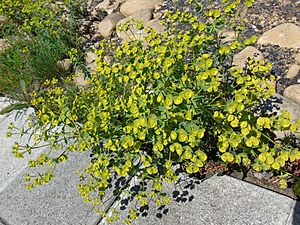Grainfield spurge facts for kids
Quick facts for kids Grainfield spurge |
|
|---|---|
 |
|
| Scientific classification | |
| Genus: |
Euphorbia
|
| Species: |
segetalis
|
| Synonyms | |
|
Euphorbia pinea |
|
The grainfield spurge, known scientifically as Euphorbia segetalis, is a type of plant that grows every year. It belongs to the Euphorbiaceae family, which is a large group of flowering plants. This plant grows upright on its own and has simple, wide leaves.
Grainfield spurge plants are often visited by different insects, including tiny ants called Plagiolepis pygmaea, types of wasps known as Polistes, and various kinds of nomad bees. These insects help the plant by carrying pollen from one flower to another. A single grainfield spurge plant can grow to be about 16 centimeters (about 6 inches) tall.
Contents
What is Grainfield Spurge?
The grainfield spurge is an annual herb. This means it completes its entire life cycle, from seed to flower to new seeds, all within one year. After producing seeds, the plant usually dies. It's called a "spurge" because many plants in the Euphorbia family produce a milky, sap-like liquid when their stems are broken. This sap can sometimes be irritating.
Where Does Grainfield Spurge Grow?
This plant is often found in places where people grow crops, like grain fields, which is how it got its common name. It also likes to grow in sunny, open areas such as vineyards, olive groves, and along roadsides. You can find Euphorbia segetalis in many parts of Europe, especially around the Mediterranean Sea, and also in North Africa. It's quite common in countries like Spain, Italy, Greece, and Malta.
How Does Grainfield Spurge Look?
Grainfield spurge is a relatively small plant. It has a main stem that grows straight up, and usually, several branches grow from the base.
Leaves and Stems
The leaves of the grainfield spurge are simple and have a smooth edge. They are usually a fresh green color and grow directly from the stem without a stalk. The leaves are often wider near the tip and narrower towards the base. The stems are smooth and can sometimes have a reddish tint, especially closer to the ground.
Flowers and Seeds
The flowers of the grainfield spurge are quite small and are grouped together in special structures called cyathia. These cyathia look a bit like tiny cups and contain both male and female parts of the flower. They are often surrounded by yellowish-green leaf-like structures called bracts, which can look like petals. After the flowers are pollinated, the plant produces small, round seed capsules. These capsules split open when they are ripe, scattering the tiny seeds. This is how the plant spreads and grows new plants each year.
Who Visits its Flowers?
The small, yellowish-green flowers of the grainfield spurge attract various insects. As mentioned, tiny ants like Plagiolepis pygmaea, different types of Polistes wasps, and several kinds of nomad bees are common visitors. These insects are important pollinators. When they visit the flowers to collect nectar or pollen, they accidentally transfer pollen from one flower to another. This helps the plant to produce seeds and continue its life cycle.
See also
 In Spanish: Euphorbia segetalis para niños
In Spanish: Euphorbia segetalis para niños

